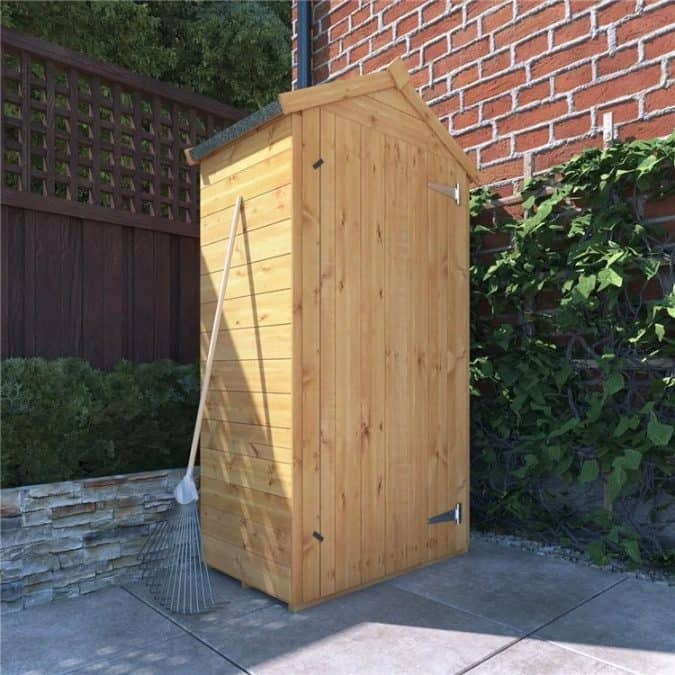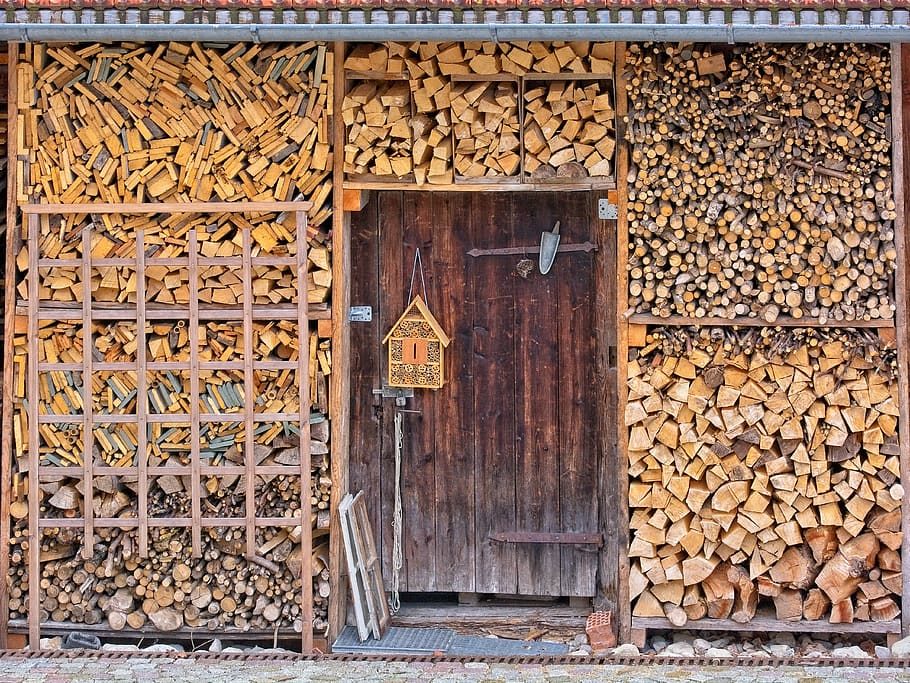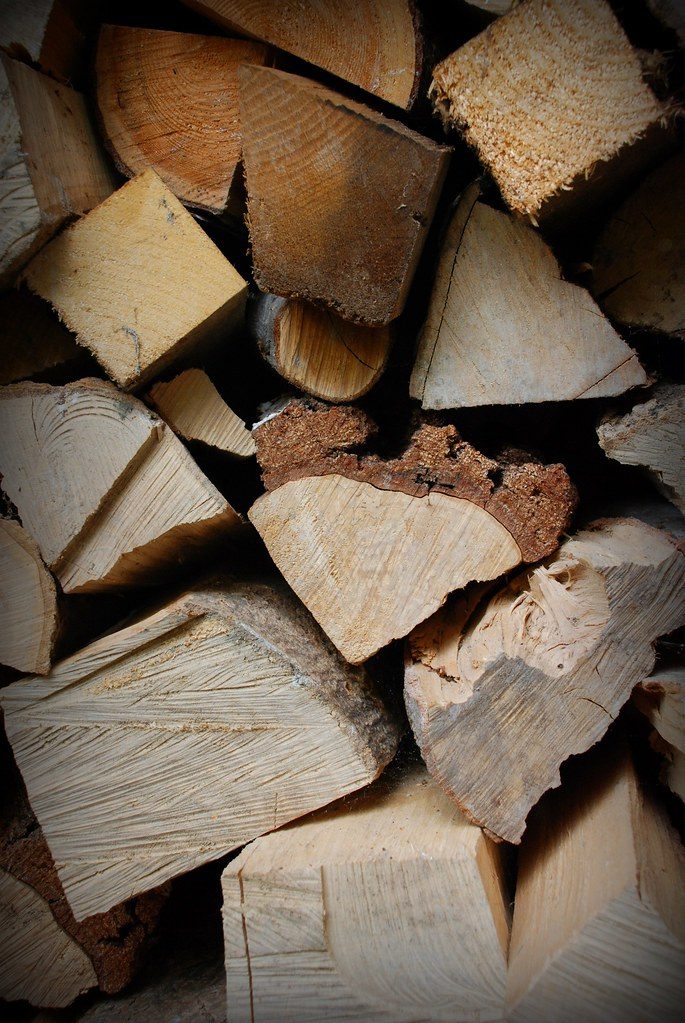Jump to:
As the sun sets on a crisp autumn evening, there’s nothing quite like the warmth and cosiness of a crackling fire. But to keep that blaze burning, you need a steady supply of dry wood.
And what better way to store those logs than in a stylish and functional log store in your own garden? A surefire way to keep your chunks of firewood dry and ready to burn!
With some basic DIY skills and a few simple materials, you can easily build your own. The provided step-by-step instructions will help you to get started.
I. Choosing the right location

The location of your log is vital to its functionality and longevity. A poorly chosen one can lead to damp, mouldy logs and even structural damage to the shelter itself.
Carefully consider the placement before you start building, and these tips might help:
- Keep it close to the house. This will make it more convenient to grab logs when you need them, especially in cold winter months.
- A level, well-drained spot. This will ensure the firewood is dry and in good condition.
- Consider the prevailing wind direction. Exposure to strong winds could cause the logs to dry out too quickly and even blow away. Keep the wood store log sheltered from the prevailing winds.
- Avoid areas with heavy foot traffic. This includes areas where kids or pets often play or are used for outdoor entertaining.
Some suitable locations are under a large tree for natural shelter and shade. Against a wall or fence for protection from the wind. Or near a shed for more convenience and access.
Overall, the position will depend on your specific garden layout and personal preferences. Take some time to assess your options before choosing the ideal spot.
II. Materials and tools
There are a variety of materials that can be used when building a log store. The choice will depend on factors like budget, design preference, and durability.
For materials, wood is a popular choice due to its natural appearance and strength. Cedar, redwood, and pressure-treated pines are all excellent choices. They all are naturally resistant to rot and decay.
Metal can also be used, such as corrugated metal, that is lightweight, durable, and has a modern look. Or go for bricks or stones for a more permanent and traditional aspect. Although low-maintenance, they’re quite costly and time-consuming to build.
In terms of tools and equipment, you may need the following:
- Circular saw or handsaw
- Drill and bits
- Hammer and nails or screws
- Level
- Measuring tape
- Shovel
- Post hole digger (if using posts)
- Concrete mix (if using posts)
It’s also a good idea to have protective gear such as gloves, eye protection, and a dust mask.
III. Building the log store

Step 1: Design and planning. Before you start building, plan out the design and size of your log store. Consider the size of the logs you will be storing, as well as the amount of space you have available in your garden. Sketch out your design on paper and make a list of the materials and tools you will need.
Step 2: Prepare the site. Clear the area where you plan to build your log garden store. If using posts, use a post-hole digger to dig holes for the posts. Mix the concrete and pour it into the holes, then place the posts into the holes and let the concrete set. If not using posts, level the ground and prepare a flat, stable base for the structure.
Step 3: Build the frame. Using your lumber, construct the frame of your log store and shelter. The size and design will depend on your specific plan. But generally, the frame will consist of vertical posts and horizontal beams. Use screws or nails to secure the frame together.
Step 4: Add the roof. Once the frame is complete, add the roofing material. This can be corrugated metal, asphalt shingles, or any roofing material of your choice. Secure the frame using screws or nails.
Step 5: Add any finishing touches. If desired, add extra features to your log storage idea, such as shelves, doors, or firewood racks. A shelving unit can allow you to stack your logs neatly and offer more room for storage. A rack, meanwhile, makes it easier to access the wood when you need it.
IV. Customisation and personalisation

There’s no reason log store ideas can’t be aesthetically pleasing and personalised to fit your needs. Decorative elements, for one, such as paint or carvings.
Touch up the structure with a brush of paint to match the colour scheme of your garden. Or add carvings of animals, nature motifs or anything you like to give it a rustic and unique look.
You may also use different materials. Instead of using traditional lumber, opt for recycled pallets, logs, or stones. This will give your log store an added charm and make it a focal point of your outdoor space.
V. Maintenance and care

Caring for and maintaining is crucial for ensuring longevity and functionality. Regularly clean your log store to remove dirt, debris, and any moisture build-up. Do this using a broom or brush, with mild detergent, to clean the structure if necessary.
The primary purpose of a log store is to keep logs dry. It only makes sense to ensure it remains dry too. Check regularly for any signs of leaks or damage to the roof or walls and fix any issues promptly. Adding a protective cover or tarp to the roof during heavy rain or snow also helps prevent water damage.
Prevent pests and decay by keeping the log store raised off the ground. Also, regularly treat the wood with a protective sealant or pesticide.
By following these tips, you can ensure that your log store remains in top condition.
Round-up
A log store is an essential addition to any home with a fireplace or wood-burning stove. It keeps your logs dry and ready to burn while providing a storage solution for your garden.
We hope our ideas have inspired you to create your own and add a touch of style to your garden. So, why not get started today? Or…click the button below to browse our amazing range of log stores right now!
Shop Log Stores




